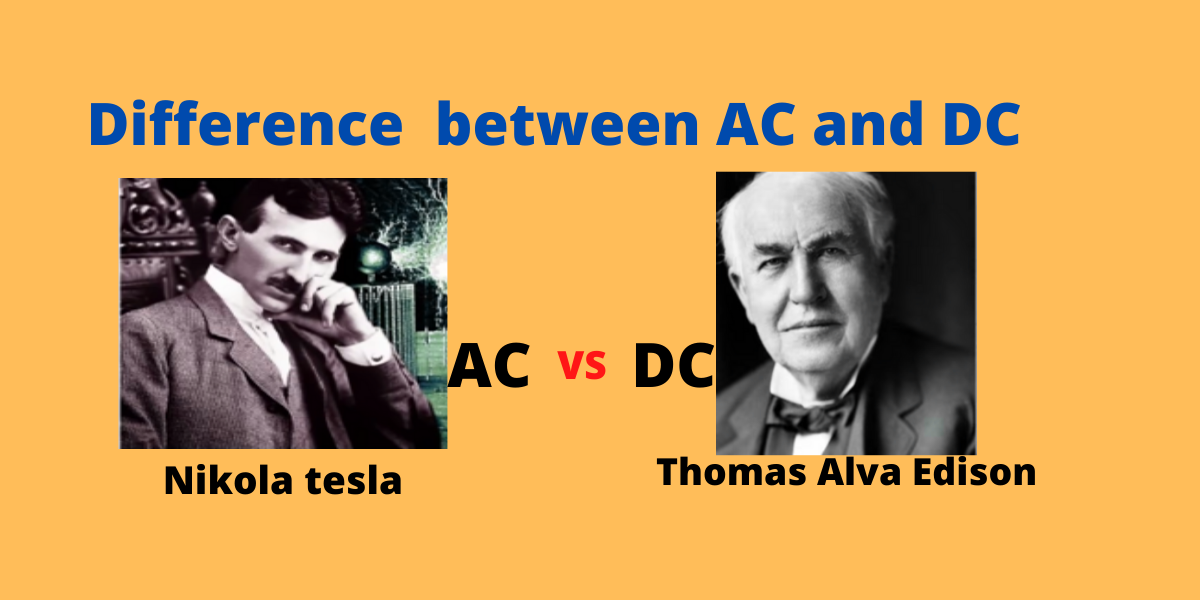Contents
AC and DC current
Let’s start with the introduction of the new article “AC and DC current.
Most of the countries in the world including India use an ac current system for the generation of electrical power. Talking about the dc supply system, it has its own importance and basic necessity for electronic devices, but the advantage of ac for electric power is that it can be easily stepped up and stepped down as per the requirement of transmission and utilization of electrical power.
Electric current flows in an electrical circuit either in the form of ac (alternating current) or in the form of dc (direct current). Electric current is nothing more than the moving electrons along a conductor, like a wire.
On the basis of the flow of electrons, electric current is classified as dc (direct current) and ac (alternating current).
Direct Current (DC)
When we talk about the direct current, the flow of electrons is steadily in one direction. It means that the direct current flows only in the forward direction. In another word, we can say that the direct current is a unidirectional flow or movement of electric charge carriers.
The Intensity of the direct current can vary with time, but the direction of flow of electric charge remains the same at all times. Direct current is of various types such as pure DC, Pulsating DC, Variable DC, etc. The electric current w produced by a battery, cell, dynamo, or any such other source is the form of direct current.

Various types of DC current
Generally, all the electronics and computer hardware require DC (Direct current) to function. Most of the solid-state devices require DC between 1.5v to 13.5v.
Alternating Current (AC)
An alternating current is a type of electric current in which the direction of the electric charge carrier, electrons changes after a regular interval of time is called an Alternating Current.
The direction of the alternating current will always get reversed after a certain interval of time. It means that the electric charge carrier keeps changing their direction or switching their direction sometimes in forward direction and then in backward direction at regular interval.
Alternating currents are generally of many types such as sine wave, triangular wave, sawtooth wave, square wave, etc. When talking about the alternating current, the electric current produced by oscillators, alternators, and audio and radio signals that are carried on an electrical cable are examples of alternating current.

In comparison to DC, AC current has various advantages over DC that’s why electrical energy is generated and used in the form of AC. Advantages of AC over DC are discussed below one by one.
Advantages of AC over DC
- The cost of transmission of Alternating current (AC) is low when compared with Direct current (DC). It means that ac can be easily transmitted from one place to another at a very cheap cost.
- Alternating current can be transmitted at very high voltage due to this the value of current remains low in the line and for low values, thin wires are used for the transmission of electric current and due to this, the cost of transmission of electric current gets reduced.
- Conversion of voltage in AC is easier. Alternating current can be easily converted from low voltage to high voltage or from high voltage to voltage as per requirement at minimum power cost. When voltage is increased then electric current decreases, whereas electric current increases on decreasing the voltage. And for this purpose, a stable static device is used which is called a transformer.
- Higher voltage production. AC can be produced up to 33kv but DC can be normally produced up to 650v. In industries and voltage transmission application of higher voltage plays an important role.
- Conversion of AC into DC is easier. It means AC can be easily converted into DC by using a rectifier. A silicon-controlled rectifier can convert AC into DC up to 100A of electric current.
- The construction of AC equipment is easy and simple as compared to equipment that works on DC. Such as the construction of the AC motor and its equipment is much easier and simple than the construction of the DC motor and its equipment.
Apart from all the above advantages, AC over DC has some disadvantages, as listed below.
Disadvantages of AC over DC
- The size of the conductor in the AC line is greater in comparison to the size of the conductor in the DC line.
- In the AC system losses are more due to the presence of skin effect. AC over DC has some disadvantages, as listed below
- DC system is more efficient than AC system.
- In an AC system insulation required is more.
- In an Ac system, there is telecommunication interference.
Comparison between AC and DC current
| Characteristics | Direct Current | Alternating Current |
| The amount of energy that can be carried. | It is safe to transfer AC over a longer distance and can provide more power. | The voltage of DC cannot travel a long distance until it begins to lose energy. |
| Frequency | The frequency of AC is 50Hz or 60Hz depending upon countries. | The frequency of DC will be zero. |
| Flow of electrons | In AC electrons keep changing their direction in forward and backward direction. | In AC electrons keep changing their direction in the forward and backward direction. |
| Direction | AC will reverse its direction when it flows in the circuit. | DC will not reverse its direction when it flows in the circuit. |
| Current | AC is the current of magnitude that varies with time. | DC is the current having constant magnitude. |
| The cause of direction of flow of electrons | AC is denoted by a rotating magnet along the wire. | DC is denoted by steady magnetism along the wire. |
| Source | AC is obtained from an alternator or ac generator, oscillators, etc. | DC is generally obtained from a cell, battery, dynamo, etc. |
| Storage | AC cannot be stored. | DC can be stored. |
| Power Factor (cosΦ) | The value of the power factor for AC lies between 0 to1. | The power factor for DC is always 1. |
I hope you like this post on ac and dc current. For more articles related to electrical engineering visit https://www.electricalmaker.com/.

Jitu Kumar is the Founder and Senior Content Head of Electrical Maker. On electricalmaker.com, we publish the latest educational updates regarding Engineering.
